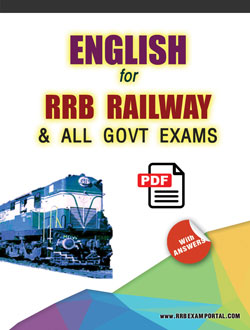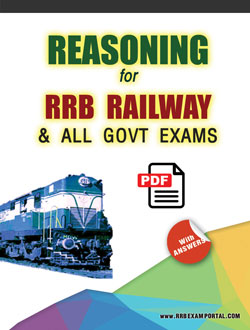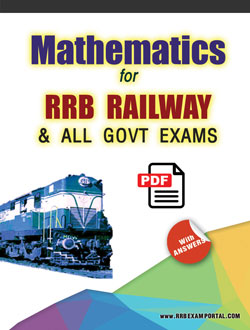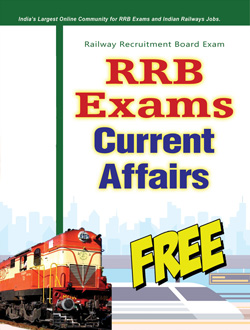Free Study Material For RRB Examination: English (English Language Comprehension)
Free Study Material For RRB Examination
Subject : English (English Language Comprehension)
Defination of Comprehension
Comprehension is the ability to read and understand
unfamiliar text matter, to answer questions based on that. You will be presented
with passages drawn from a variety of subject areas, including humanities, the
sciences, latest happenings in society etc. The questions will ask you to
analyze what is stated in the passage and you would have to identify underlying
assumptions and implications. The passage may be followed by 3-10 questions to
check the thorough understanding of the contents. The questions will be
objective type with each question followed by four answer options out of which
the most appropriate one is to be chosen on the basis of the information given
in the passage. No outside information or data should be used while answering
the questions and answers should simply be marked keeping in mind the author’s
viewpoints on the topic.
The passages could be written in the following styles
1. Analytical: The analytical way of writing usually presents the pros and cons of the issue at hand. It discusses both sides of the issue and the author may after analysis, present his final viewpoint in the end. The questions are usually about the main idea and the author’s viewpoint.
2. Discursive: A discursive style of writing is where the author discusses various aspects of certain issues in brief and superficially. Hence, the questions that follow are simple and basic questions on theme and the facts presented therein.
3. Argumentative: The argumentative style of writing is where the author supports his viewpoint on an issue by presenting facts and data which support his viewpoint. Unlike the argumentative style, he does not present both sides of the issue. The questions that follow are mostly about the author’s tone and whether he would agree or disagree with certain points on the issues as discussed in the passage.
4. Descriptive/Narrative: When the passage describes a certain event or phenomenon chances are it uses the descriptive style of writing. In simple words descriptive style of writing uses story telling format. It is lucid and easy to understand and is usually followed by easy questions on the main theme or the facts stated in the passage.
Suggestions
1. Use only the information given or implied in a passage. Do
not consider outside information, even if it seems more accurate than the given
information.
2. You are looking for the best answer, so be sure to read all the choices.
3. If you don’t know the answer, try to eliminate some choices and then take an
educated guess.
4. Because you may refer to the passage, don’t try to memorize everything in the
passage.
5. Read the passage focusing on the main point or purpose and the structure of
the passage.
Exercise :-
Direction : Read the following passages carefully and answer the questions that follow
Passage :-
Nobel prize winner Joseph E. Stiglitz, described “globalisation as a double-edged sword. For those willing to seize the opportunities and manage globalisation on their own terms, it has provided the basis of unprecedented growth.” Taking full advantage of globalisation India has managed a historically unprecedented growth rate for more than a decade and half. Following the Washington consensus in the last quarter of 20th century, international institutions including the World Bank and the International Monetary Fund mounted a sustained campaign to push liberalisation of national economies and privatisation of their public sector. Empirical studies have amply demonstrated that the benefits of the globalisation have not been shared by all the countries. Even in the same country, the benefits arising out of globalisation have not filtered to the various strata of the population and disparities have widened. Thus, there are transparent inequalities amongst the countries as also within the same Country. India is no exception to the latter. In most of the poorer countries like Africa growth rates have not registered any improvements and the number of people below poverty line has in some cases doubled. Moreover there is reluctance of developed countries in removing the trade distorting subsidies in agriculture and giving duty-free market access to the least developed countries with very limited exportable products.
The issue is how has India reaped benefits of globalisation ? To assume that economic, fiscal, trade and allied policies initiated by the government created an environment which facilitated economic advancement on these fronts will amount to manipulation of ground realities. The foremost factor which engineered the growth in India was emergence of a self-reliant middle class equipped with strong knowledge base with technical qualifications. They pursued innovative businesses requiring managerial and technical skills in the upcoming sectors like information technology and other allied fields. Instead of the traditional industry-led growth path followed by the west and other developing countries India opted for services-led growth which had visible, tangible results. In the manufacturing sector, technological innovation, low-cost production, ability to quickly adapt to changes, establishing world class R & D facilities etc., greatly helped in successfully meeting global competition.
The automobile industry is a classic example. Strong presence
of Non-Resident Indians (NRIs) in the developed countries occupying senior
management positions in several multinational corporations built confidence in
Indian managerial competence and leadership. This promoted MNCs’ networking with
India (as also in China) with its expanding domestic market which in the present
circumstances remained the only viable option for their sustained growth in
future. The success stories of businesses controlled by NRIs in the western
markets established India’s reputation as dependable and disciplined
businessmen. Well established democratic political framework, large young
population ingrained with absorption capacity of new technologies have all
created a responsive realisation that India is marching ahead. The initiative
largely of its private sector in expanding connectivity by improved
telecommunications, low-cost air transportation and vast press, TV and other
media penetration ignited awareness amongst all sections of its people of a
bright future and thus radically changed their peroeption, thinking and actions.
Furthermore the entire world took note of unexploited potentials of India in
becoming a competitive centre of excellence and cost efficiency.
1. According to the author, which of the following was primarily responsible for India’s growth ?
(a) Well developed and implemented economic, fiscal and trade
policies
(b) Detailed microlevel analysis of the economy
(c) A workforce with managerial rather than technical qualifications
(d) None of the above
Directions (Q. Nos. 2 to 3): Choose the word which is most nearly the same in meaning as the word given in bold as used in the passage.
2. mounted
(a) increased
(b) grew
(c) organised
(d) climbed
3. tangible
(a) valuable
(b) complex
(c) touch
(d) concrete
Directions (Q. No. 4): Choose the word which is most opposite in meaning of the word given in bold as used in the passage.
4. viable
(a) indirect
(b) impractical
(c) unsatisfied
(d) unpleasant





